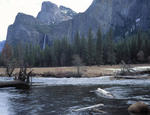Quote
Enny
Was for the upper fall the angle of the sun towards the waterfall and water fall angle important? I'm asking because the sun was perpendicular to the waterfall.
The position of the waterfall itself doesn't matter so much; it's the position of the
spray and the
sun relative to you (the observer) that determines if/when/where there'll be a rainbow.
Assuming that the sun is somewhere behind you, find (or imagine) the shadow of your head. For you to cast a shadow at all, the sun is going to have to be above the horizon so the shadow of your head will be somewhere on the ground. Call that point "P". With P as the center, draw an imaginary circle with a radius of about 42 degrees (or a diameter of about 84 degrees). If there's rain, waterfall spray, garden hose spray, or any other water droplets anywhere along that circle, you'll see a rainbow there.
If you move, the circle will move. If the sun moves (which of course it will), the circle will move. As long as you keep moving in such a way that the magic circle intersects spray, you'll continue to see the rainbow. Not responsible for clouds, ridges, trees, etc. getting in the way of the sun.
How big is 42 degrees, you ask? Imagine the last full-size rainbow you saw. That was part of a circle with a radius of 42 degrees. You could make a rainbow gauge by attaching one yardstick to the end of another at right angles. if you point the first yardstick at the shadow of your head, the 32.4-inch mark on the second yardstick will point to the magic circle where rainbows can form. These calculations not guaranteed till I've tried them out (don't anyone hold your breath).








